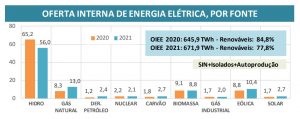Photovoltaic solar energy production is expected to reach 18 TWh in 2021, an increase of 67% compared to the 10.7 TWh seen in 2020. Of this total, DG (distributed generation) will have the biggest growth, generating 10.8 TWh in 2021 , against 4.8 TWh in 2020, an increase of around 125%.
The data was released last week in the August Monthly Energy Bulletin, carried out by the DIE (Department of Information and Energy Studies), of the Secretariat of Energy Planning and Development of the MME (Ministry of Mines and Energy).
In addition to the photovoltaic source, wind power should also be significant this year compared to last year. According to the bulletin, wind energy generation could reach just over 70 TWh, representing an increase of 23% compared to 2020.
In contrast to solar and wind, other renewable sources are expected to see a decline in generation in 2021. The bulletin pointed out that hydraulic energy is expected to decline by around 10% due to severe drought. The document also showed that the offer of Itaipu is negative at 31.1% in the year to date.
Furthermore, biomass consumption – for industrial heat and electricity generation – is expected to decline sharply in the sugar and alcohol sector and moderate in the rest of agriculture. Due to the decline of these sources, which have a large presence in the Brazilian energy matrix, it is estimated that renewables will have a smaller share in the energy and electrical matrix in 2021, compared to 2020.
The bulletin also pointed out that the OIE (Internal Energy Supply), the energy necessary to drive the country's economy, is expected to grow by 4.5% in 2021. The OIE is expected to have 44.4% of renewables, compared to 48.4% in 2020. (See below)

Fossil sources
The Monthly Energy Bulletin also showed that fossil sources are expected to grow by around 10%, mainly due to the recovery of transport and industry, affected by the Covid-19 pandemic in 2020, and due to greater thermoelectric generation, as a result of the drought that worsened in 2021.
















